As Neil Gaiman states in the introduction to Shaun Tan’s The Singing Bones (2016): “People need stories.... They entertain us and they change us, as they have changed and entertained us for thousands of years.”
I was fortunate to grow up learning nursery rhymes and listening to fairy tales, and once I could read on my own, I devoured the books in the folklore section of my local library. Today’s children need to hear and read these stories. Here is a selection of fairy tales, myths, and legends published in 2016, including new editions of classic collections in addition to fresh retellings of tales I recommend adding to personal, classroom, and library collections.
Ages 4–8
Hare and Tortoise. Alison Murray. 2016. Candlewick.
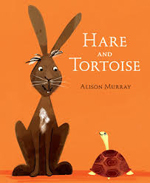 In her fresh and lively retelling of this Aesop fable, Murray introduces Hare (Leapus swifticus) and Tortoise (Slow and steadicus) with profiles, statements of their racing capabilities, and quotes from the two racers. After a “Ready…Steady…Cock-a-doodle-GO!” from a rooster to start the race, the brightly colored, digitally created illustrations show the two competitors on the race course, with Hare leaping through the tickliest grass and the meadow while Tortoise plods along the bottom of the page. Hare brags, “I’m the fastest on the farm. No one can beat me!” Tortoise says “I may be slow, but I’ll give it a go.” Overconfident Hare’s stopping to munch on carrots and nap leads to Tortoise’s victory. In a show of good sportsmanship, Tortoise suggests a rematch: a race to the lettuce patch.
In her fresh and lively retelling of this Aesop fable, Murray introduces Hare (Leapus swifticus) and Tortoise (Slow and steadicus) with profiles, statements of their racing capabilities, and quotes from the two racers. After a “Ready…Steady…Cock-a-doodle-GO!” from a rooster to start the race, the brightly colored, digitally created illustrations show the two competitors on the race course, with Hare leaping through the tickliest grass and the meadow while Tortoise plods along the bottom of the page. Hare brags, “I’m the fastest on the farm. No one can beat me!” Tortoise says “I may be slow, but I’ll give it a go.” Overconfident Hare’s stopping to munch on carrots and nap leads to Tortoise’s victory. In a show of good sportsmanship, Tortoise suggests a rematch: a race to the lettuce patch.
Little Red. Bethan Woollvin. 2016. Peachtree.
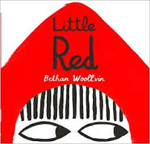 Meeting a wolf in the woods on her way to Grandma’s house, “which might have scared some little girls,” does not scare Little Red. The wolf, of course, takes a shortcut—an unlucky turn of events for Grandma. When Little Red arrives, she peeps through the window and sees the badly disguised wolf in Grandma’s bed, “which might have scared some little girls,” but not Little Red. Just as the wolf leaps to devour her, Little Red surprises the unlucky wolf with an ax. Little Red returns home wearing a wolf fur outfit. The bold graphic illustrations, created with only black, gray, and touches of red on expansive white backgrounds, are a perfect match for the text. The result is a more humorous and darker retelling of the traditional tale, as all ends well for brave and clever Little Red, but not for Grandma.
Meeting a wolf in the woods on her way to Grandma’s house, “which might have scared some little girls,” does not scare Little Red. The wolf, of course, takes a shortcut—an unlucky turn of events for Grandma. When Little Red arrives, she peeps through the window and sees the badly disguised wolf in Grandma’s bed, “which might have scared some little girls,” but not Little Red. Just as the wolf leaps to devour her, Little Red surprises the unlucky wolf with an ax. Little Red returns home wearing a wolf fur outfit. The bold graphic illustrations, created with only black, gray, and touches of red on expansive white backgrounds, are a perfect match for the text. The result is a more humorous and darker retelling of the traditional tale, as all ends well for brave and clever Little Red, but not for Grandma.
The Princess and the Warrior: A Tale of Two Volcanoes. Duncan Tonatiuh. 2016. Abrams.
 In Tonatiuh’s retelling of this Mexican legend, illustrated with his signature Mixtec codices–inspired art, a princess named Izta falls in love with Popoca, a warrior, who vows to stay by her side no matter what. Her emperor father agrees to the marriage only if Popoca defeats his enemy Jaguar Claw, the ruler of a neighboring kingdom. When, after numerous battles, it becomes clear that Popoca will win, the evil Jaguar Claw bribes one of Popoca’s messengers to report to Izta that Popoca is dead and to offer her a potion to ease her grief. Izta drinks the poisonous potion and fall into a deep sleep from which she never wakes. Popoca returns the victor and keeps his vow to stay by Izta’s side forever. Now, where once there was a princess with her true love by her side, there are two volcanoes: Iztaccíhuatl (sleeping woman) and Popocatépetl (smoky mountain). Back matter includes an author’s note, a glossary, and a bibliography. An interesting volcano news connection: An unusually long and strong explosion of Popocatépetl occurred last month.
In Tonatiuh’s retelling of this Mexican legend, illustrated with his signature Mixtec codices–inspired art, a princess named Izta falls in love with Popoca, a warrior, who vows to stay by her side no matter what. Her emperor father agrees to the marriage only if Popoca defeats his enemy Jaguar Claw, the ruler of a neighboring kingdom. When, after numerous battles, it becomes clear that Popoca will win, the evil Jaguar Claw bribes one of Popoca’s messengers to report to Izta that Popoca is dead and to offer her a potion to ease her grief. Izta drinks the poisonous potion and fall into a deep sleep from which she never wakes. Popoca returns the victor and keeps his vow to stay by Izta’s side forever. Now, where once there was a princess with her true love by her side, there are two volcanoes: Iztaccíhuatl (sleeping woman) and Popocatépetl (smoky mountain). Back matter includes an author’s note, a glossary, and a bibliography. An interesting volcano news connection: An unusually long and strong explosion of Popocatépetl occurred last month.
The Teeny-Tiny Woman (Folk Tale Classics). Paul Galdone. 2016. Houghton Mifflin Harcourt.
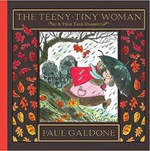 The rhythmic repetition of “teeny-tiny” throughout the story of the teeny-tiny woman who finds a teeny-tiny bone in a teeny-tiny churchyard’s cemetery and takes it home intending to use in a teeny-tiny soup makes this a fun book to read aloud. When a teeny-tiny voice coming from the cupboard where she has put the bone increases in volume as it says, “Give me my bone,” however, the tale becomes a teeny-tiny bit scary. Over the years there have been other illustrated retellings of this traditional English tale, but Galdone’s delightfully folksy illustrations make his The Teeny-Tiny Woman, which was originally published in 1984, the classic retelling.
The rhythmic repetition of “teeny-tiny” throughout the story of the teeny-tiny woman who finds a teeny-tiny bone in a teeny-tiny churchyard’s cemetery and takes it home intending to use in a teeny-tiny soup makes this a fun book to read aloud. When a teeny-tiny voice coming from the cupboard where she has put the bone increases in volume as it says, “Give me my bone,” however, the tale becomes a teeny-tiny bit scary. Over the years there have been other illustrated retellings of this traditional English tale, but Galdone’s delightfully folksy illustrations make his The Teeny-Tiny Woman, which was originally published in 1984, the classic retelling.
Ages 9–11
Beauty and the Beast. Mahlon F. Craft. Ill. Kinuko Y. Craft. 2016. Harper/HarperCollins.
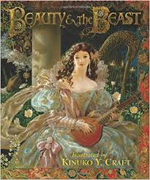 The Crafts have created a beautiful picture book adaptation of the well-loved tale of Beauty and the Beast by Jeanne-Marie Leprince de Beaumont, first published in France in 1756. The blocks of text of Mahlon F. Craft’s well-crafted retelling, which are on the left-hand pages, begin with decorative illuminated letters. Kinuko Y. Craft’s exquisite oil-over-watercolor illustrations are on the right-hand pages. In addition, there are three double-page wordless spreads presenting key scenes from the tale. The rich detailing of both text and illustrations of this adaptation of the traditional tale will appeal to middle-grade readers. It is a fine addition to classroom and library collections of fairy tales.
The Crafts have created a beautiful picture book adaptation of the well-loved tale of Beauty and the Beast by Jeanne-Marie Leprince de Beaumont, first published in France in 1756. The blocks of text of Mahlon F. Craft’s well-crafted retelling, which are on the left-hand pages, begin with decorative illuminated letters. Kinuko Y. Craft’s exquisite oil-over-watercolor illustrations are on the right-hand pages. In addition, there are three double-page wordless spreads presenting key scenes from the tale. The rich detailing of both text and illustrations of this adaptation of the traditional tale will appeal to middle-grade readers. It is a fine addition to classroom and library collections of fairy tales.
D’Aulaires’ Book of Norwegian Folktales. Ingri d’Aulaire and Edgar Parin d’Aulaire. 2016. University of Minnesota.
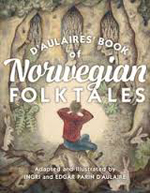 This renamed edition of the d’Aulaires’ classic East of the Sun and West of the Moon, originally published in 1938, remains the best collection for introducing children to Norwegian folktales. In the introduction, the d’Aulaires give a brief history of the folklore of Norway, including the role of Asbjörnsen and Moe in collecting the oral tales in the 19th century and the first translation of the tales into English, and tell of the difficulty they had in deciding which tales and illustrations to include in their collection. The 21 tales of princesses, trolls, talking animals, and heroes, which are best enjoyed through being read aloud, introduce children to motifs of Norwegian folklore. Many of the tales involve princes and knights attempting seemingly impossible feats to win a princess and half of a kingdom; the unlikely young hero Cinderlad is often the one who succeeds.
This renamed edition of the d’Aulaires’ classic East of the Sun and West of the Moon, originally published in 1938, remains the best collection for introducing children to Norwegian folktales. In the introduction, the d’Aulaires give a brief history of the folklore of Norway, including the role of Asbjörnsen and Moe in collecting the oral tales in the 19th century and the first translation of the tales into English, and tell of the difficulty they had in deciding which tales and illustrations to include in their collection. The 21 tales of princesses, trolls, talking animals, and heroes, which are best enjoyed through being read aloud, introduce children to motifs of Norwegian folklore. Many of the tales involve princes and knights attempting seemingly impossible feats to win a princess and half of a kingdom; the unlikely young hero Cinderlad is often the one who succeeds.
Jason and the Argonauts: The First Great Quest in Greek Mythology. Robert Byrd. 2016. Dial/Penguin.
 Following an introduction to the ancient Greek tale of Jason and the Argonauts, one of the oldest recorded Greek myths, Robert Byrd uses a series of lavishly illustrated double-page spreads to present key episodes of mortal Jason’s quest to retrieve the Golden Fleece. Jason and the Argonauts (kings, princes, other noblemen, warriors, sages, and the sons of gods and goddesses) were helped and hindered by interactions with the gods as they fought epic battles with giants, harpies, man-eating Stymphalian birds, fire-breathing bulls, and other monsters. The double-page entries with detailed story-text and sidebars profiling key figures work well for chapter-a-day-type read-aloud and discussion sessions. The endpapers show a map of the route of the Argo. Back matter includes a chart of the Olympians, an author’s note, and a bibliography.
Following an introduction to the ancient Greek tale of Jason and the Argonauts, one of the oldest recorded Greek myths, Robert Byrd uses a series of lavishly illustrated double-page spreads to present key episodes of mortal Jason’s quest to retrieve the Golden Fleece. Jason and the Argonauts (kings, princes, other noblemen, warriors, sages, and the sons of gods and goddesses) were helped and hindered by interactions with the gods as they fought epic battles with giants, harpies, man-eating Stymphalian birds, fire-breathing bulls, and other monsters. The double-page entries with detailed story-text and sidebars profiling key figures work well for chapter-a-day-type read-aloud and discussion sessions. The endpapers show a map of the route of the Argo. Back matter includes a chart of the Olympians, an author’s note, and a bibliography.
Ages 12–14
Divine Comedies: A Gift From Zeus and The Old Testament Made Easy. Jeanne Steig. Ill. William Steig. 2016. Caitlyn Dlouhy/Atheneum/Simon & Schuster.
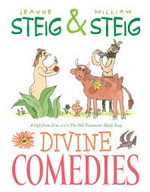 Divine Comedies includes two Steig collaborations: A Gift From Zeus (originally published in 2011) and The Old Testament Made Easy (originally published in 1990). The droll and bawdy humor of Jeanne Steig’s classic stories from Greek mythology, told in prose with a scattering of light verse, and the Old Testament, told in verse, and the humorous and at times playfully naughty pen-and-watercolor cartoon artwork of William Steig make this collection of stories delightfully irreverent fare for sophisticated readers.
Divine Comedies includes two Steig collaborations: A Gift From Zeus (originally published in 2011) and The Old Testament Made Easy (originally published in 1990). The droll and bawdy humor of Jeanne Steig’s classic stories from Greek mythology, told in prose with a scattering of light verse, and the Old Testament, told in verse, and the humorous and at times playfully naughty pen-and-watercolor cartoon artwork of William Steig make this collection of stories delightfully irreverent fare for sophisticated readers.
Tales From the Arabian Nights: Stories of Adventure, Magic, Love, and Betrayal. Donna Jo Napoli. Ill. Christina Balit. 2016. National Geographic.
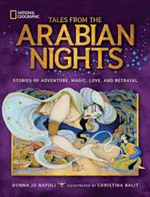 In a strong storytelling voice, Donna Jo Napoli presents 49 of the 1,001 stories Scheherazade tells to her husband, who has vowed to take a new wife each day and to kill her the next morning to avoid ever being betrayed again as he was by his unfaithful first wife. For those not ready to take on independent reading of the book, listening to some of the tales will be a treat. Older children reading the book on their own will enjoy the frame story and how the tales link together, as well as Christina Balit’s exquisite artwork, which incorporates Middle Eastern motifs and cultural details in rich colors. An introduction and sidebars of related historical and cultural details add interest. Back matter includes a postscript in which Napoli discusses her selection of stories, a map of the Middle East, sources and bibliography, and an index.
In a strong storytelling voice, Donna Jo Napoli presents 49 of the 1,001 stories Scheherazade tells to her husband, who has vowed to take a new wife each day and to kill her the next morning to avoid ever being betrayed again as he was by his unfaithful first wife. For those not ready to take on independent reading of the book, listening to some of the tales will be a treat. Older children reading the book on their own will enjoy the frame story and how the tales link together, as well as Christina Balit’s exquisite artwork, which incorporates Middle Eastern motifs and cultural details in rich colors. An introduction and sidebars of related historical and cultural details add interest. Back matter includes a postscript in which Napoli discusses her selection of stories, a map of the Middle East, sources and bibliography, and an index.
Ages 15+
The Singing Bones: Inspired by Grimms’ Fairy Tales. Shaun Tan. 2016. Arthur A. Levine/Scholastic.
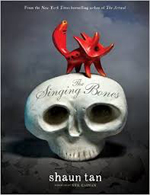 This beautifully designed book features 75 small sculptures inspired by the fairy tales of Jacob and Wilhelm Grimm. Shaun Tan created the sculptures, which vary in size from about 2 to 16 inches in height, with papier-mâché, air-drying clay, paint, and miscellaneous other materials and natural objects. A photograph of each sculpture is paired with a short excerpt from a fairy tale, some familiar and some lesser known. Each of the sculptures and selected passages is thought-provoking; some, reflecting the dark side of tales, are unsettling. Neil Gaiman’s foreword offers an appreciation of The Singing Tree, and Jack Zipes’s essay “How the Brothers Grimm Made Their Way Into the World” provides a historical context for the book. In an afterword, Tan discusses his personal connection to the Grimms’ tales, the influence of Inuit stone carvings and pre-Columbian clay figurines on his artwork, and the materials and processes he used in creating his sculptures. Back matter includes an annotated index with brief summaries of the Grimms’ fairy tales and a recommended list for further reading for those wishing to read the entire tales.
This beautifully designed book features 75 small sculptures inspired by the fairy tales of Jacob and Wilhelm Grimm. Shaun Tan created the sculptures, which vary in size from about 2 to 16 inches in height, with papier-mâché, air-drying clay, paint, and miscellaneous other materials and natural objects. A photograph of each sculpture is paired with a short excerpt from a fairy tale, some familiar and some lesser known. Each of the sculptures and selected passages is thought-provoking; some, reflecting the dark side of tales, are unsettling. Neil Gaiman’s foreword offers an appreciation of The Singing Tree, and Jack Zipes’s essay “How the Brothers Grimm Made Their Way Into the World” provides a historical context for the book. In an afterword, Tan discusses his personal connection to the Grimms’ tales, the influence of Inuit stone carvings and pre-Columbian clay figurines on his artwork, and the materials and processes he used in creating his sculptures. Back matter includes an annotated index with brief summaries of the Grimms’ fairy tales and a recommended list for further reading for those wishing to read the entire tales.
Carolyn Angus is former director of the George G. Stone Center for Children's Books, Claremont Graduate University, in Claremont, CA.